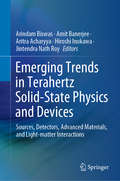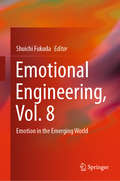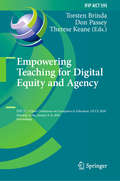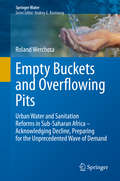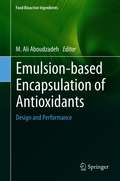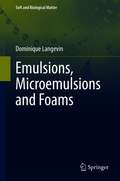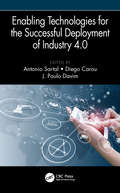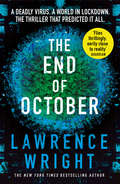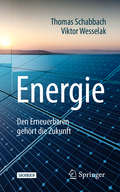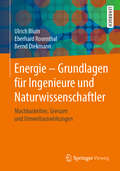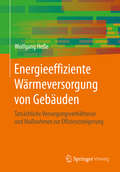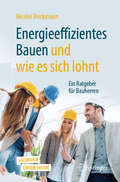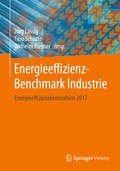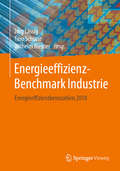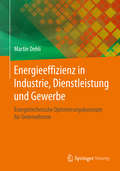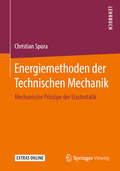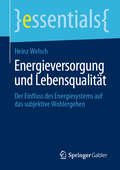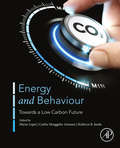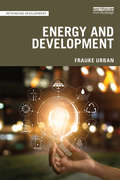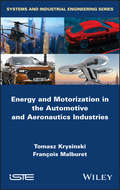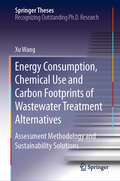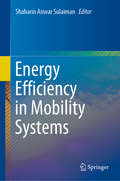- Table View
- List View
Emerging Trends in Terahertz Solid-State Physics and Devices: Sources, Detectors, Advanced Materials, and Light-matter Interactions
by Arindam Biswas Amit Banerjee Aritra Acharyya Hiroshi Inokawa Jintendra Nath RoyThis book highlights recent advances and applications in terahertz (THz) technology, addressing advanced topics such as THz biomedical imaging, pattern recognition and tomographic reconstruction for THz biomedical imaging by machine learning and artificial intelligence, THz imaging radars for autonomous vehicle applications, and THz imaging systems for security and surveillance. It also discusses theoretical, experimental, established and validated empirical work on these topics.
Emotional Engineering, Vol. 8: Emotion in the Emerging World
by Shuichi FukudaThis book is focused on the importance of detecting people’s motivation, how they make decisions and the way the actions they take is rapidly increasing with the progress of IoT and the Connected Society. It explores how emotion-related processes are increasing in importance rapidly. The contributors move through a variety of related topics, all aimed at revealing how humans and things must increasingly interact. It indicates how strategy becomes increasingly important, particularly creating the best adaptable strategy to respond to the quickly and extensively changing situations. With engineering quickly moving from product development to experience development, and the role of emotion in engineering becoming increasingly apparent, this book offers a timely and valuable resource for engineers and researchers alike.
Empowering Teaching for Digital Equity and Agency: IFIP TC 3 Open Conference on Computers in Education, OCCE 2020, Mumbai, India, January 6–8, 2020, Proceedings (IFIP Advances in Information and Communication Technology #595)
by Torsten Brinda Don Passey Therese KeaneThis book constitutes the refereed post-conference proceedings of the IFIP TC 3 Open Conference on Computers in Education, OCCE 2020, held in Mumbai, India, in January 2020. The 11 full papers and 4 short papers included in this volume were carefully reviewed and selected from 57 submissions. The papers discuss key emerging topics and evolving practices in the area of educational computing research. They are organized in the following topical sections: computing education; learners’ and teachers’ perspectives; teacher professional development; the industry perspective; and further aspects.
Empty Buckets and Overflowing Pits: Urban Water and Sanitation Reforms in Sub-Saharan Africa – Acknowledging Decline, Preparing for the Unprecedented Wave of Demand (Springer Water)
by Roland WerchotaThis book provides a multi-level and multi-dimensional insight into urban water and sanitation development by analyzing sector reforms in Africa. With the recent events in mind - water shortages in Cape Town, widespread cholera in Haiti, mass-migration from low-income countries, etc. – it elaborates a pressing topic which is directly linked to the precarious living conditions of the urban poor in the developing countries. It is urgent to acknowledge the proposed findings and recommendations of the book which will help to improve the situation of potential refugees in their home countries with a realistic vision for the development of the most basic of all life supporting services.So many efforts to reverse the negative trend in water and sanitation development have failed or targets have been repeatedly missed by far without notable consequences for decision makers on different levels and institutions. It has unnecessarily consumed many young lives, contributed to keep billions in poverty until today and fostered discrimination of women. The knowledge gap and the confusion in the sector lined out in the book becomes evident when a national leader in a low-income country declares a state of emergency in urban water and sanitation while at the same time global monitoring publishes an access figure for urban water of over 90% for the same country. It is time to change this with an effective sector development concept for our partner countries and a more realistic discourse on global level.The book argues for a sweeping rethinking and combines extended local knowledge, lessons learned from history in advanced countries and thorough research on reforms in Francophone and Anglophone developing countries. This was possible because the writer was working in Sub-Saharan partner countries for almost 30 years as an integrated long term advisor in different sector institutions (ministry, regulator, financing basket and different sizes of utilities) and had the opportunity to cooperate closely with the main development partners.The reader has the opportunity to obtain a comprehensive understanding of how the sector works and sector institutions in low-income countries function and can discover the reasons behind success and failures of reforms. The book also covers issues which have a significant influence on urban water and sanitation development but are hardly the subject of discussions. It helps to make the shortcomings of the water and sanitation discourse more apparent and assist institutions to move beyond their present perceptions and agendas. All of this makes the book different from other literature about urban water and sanitation in the developing world.
Emulsion‐based Encapsulation of Antioxidants: Design and Performance (Food Bioactive Ingredients)
by M. Ali AboudzadehThe limited aqueous solubility of bioactive pharmaceutical ingredients presents a tremendous challenge in the development of new drugs. In recent years, methods have been developed to protect these sensitive bioactive compounds, namely antioxidants, with the aim of increasing the public sanitation grades. Emulsion-based systems are particularly interesting as colloidal delivery encapsulation systems, because they can easily be created from food-grade ingredients using relatively simple processing protocols. It is one of the most favorable delivery systems to increase the solubility of phytochemicals, nutraceuticals and food additives.Emulsion‐based Encapsulation of Antioxidants: Design and Performance advances the field of colloid science through the investigation of the effects of formulation and process parameters that influence emulsion production. The book offers a deeper comprehension of the technological and biological aspects of the incorporation of encapsulated compounds in food matrices and explication of their activity. Chapters provide an overview of the status of emulsion-based formulations to encapsulate antioxidants, fabrication, properties, applications, and biological fate with emphasis on systems suitable for utilization within industry. Special emphasis is placed on the antioxidant activity of the carriers being the key advantage of these emulsion-based systems. The main aim of the book is to inspire and to guide fellow scientists and students in this field. Filled with illustrations, figures, case studies, practical examples, and historical perspectives, the book can also be used as a practical handbook or graduate textbook. For industry professionals, the book presents easy-to-achieve approaches to industrial pharmaceutical production.
Emulsions, Microemulsions and Foams (Soft and Biological Matter)
by Dominique LangevinThis book takes an interface science approach to describe and understand the behavior of the dispersions we call emulsions, microemulsions and foams. The one thing all these dispersions have in common is the presence of surface-active species (surfactants) adsorbed at the interfaces between the two fluid phases that make up the emulsions, microemulsions or foams. The interfacial layers formed by the surfactants control most of the properties of the dispersions. The book describes the properties of interfacial layers, thin films and bulk fluids used in the elaboration of the various dispersions and it explains how such properties relate to the dispersion properties of these soft matter systems: structure, rheology and stability. These dispersion properties are far from being fully understood, in particular foam and emulsion stability. In discussing the state of the art of the current knowledge, the author draws interesting parallels between emulsions, microemulsions and foams that enlighten the interpretation of previous observations and point to a deeper understanding of the behavior of these materials in the future.
Enabling Technologies for the Successful Deployment of Industry 4.0 (Manufacturing Design and Technology)
by Antonio Sartal Diego Carou J. Paulo DavimThis book offers the latest research advances in the field of Industry 4.0, focusing on enabling technologies for its deployment in a comprehensive way. This book offers successful implementation of technologies such as artificial intelligence, augmented and virtual reality, autonomous and collaborative robots, cloud computing, and up-to-date guidelines. It investigates how the technologies and principles surrounding Industry 4.0 (e.g., interoperability, decentralized decisions, information transparency, etc.) serve as support for organizational routines and workers (and vice versa). Included are applications of technologies for different sectors and environments as well as for the supply chain management. It also offers a domestic and international mix of case studies that spotlight successes and failures. Features Provides a historical review of Industry 4.0 and its roots Discusses the applications of technologies in different sectors and environments (e.g., public vs. private) Presents key enabling technologies for successful implementation in any industrial and service environment Offers case studies of successes and failures to illustrate how to put theory into practice Investigates how technologies serve as support for organizational routines and workers
Enabling Technologies for the Successful Deployment of Industry 4.0 (Manufacturing Design and Technology)
by Antonio Sartal Diego Carou J. Paulo DavimThis book offers the latest research advances in the field of Industry 4.0, focusing on enabling technologies for its deployment in a comprehensive way. This book offers successful implementation of technologies such as artificial intelligence, augmented and virtual reality, autonomous and collaborative robots, cloud computing, and up-to-date guidelines. It investigates how the technologies and principles surrounding Industry 4.0 (e.g., interoperability, decentralized decisions, information transparency, etc.) serve as support for organizational routines and workers (and vice versa). Included are applications of technologies for different sectors and environments as well as for the supply chain management. It also offers a domestic and international mix of case studies that spotlight successes and failures. Features Provides a historical review of Industry 4.0 and its roots Discusses the applications of technologies in different sectors and environments (e.g., public vs. private) Presents key enabling technologies for successful implementation in any industrial and service environment Offers case studies of successes and failures to illustrate how to put theory into practice Investigates how technologies serve as support for organizational routines and workers
The End of October: A page-turning thriller that warned of the risk of a global virus
by Lawrence WrightA DEADLY VIRUS. QUARANTINE. A WORLD IN LOCKDOWN. THE THRILLER THAT PREDICTED IT ALL. 'An eerily prescient novel about a devastating virus that begins in Asia before going global . . . A page-turner that has the earmarks of an instant bestseller.' New York Post'Eerily prescient. Too bad our leaders lack his foresight.' The New York TimesA race-against-time thriller, as one man must find the origin and cure for a new killer virus that has brought the world to its knees.At an internment camp in Indonesia, forty-seven people are pronounced dead with a mysterious fever. When Dr Henry Parsons - microbiologist and epidemiologist - travels there on behalf of the World Health Organization to investigate, what he finds will soon have staggering repercussions across the globe: an infected man is on his way to join the millions of worshippers in the annual Hajj to Mecca. As international tensions rise and governments enforce unprecedented measures, Henry finds himself in a race against time to track the source and find a cure – before it’s too late . . .***'Featuring accounts of past plagues and pandemics, descriptions of pathogens and how they work, and dark notes about global warming, the book produces deep shudders . . . A disturbing, eerily timed novel.' Kirkus Reviews'A compelling read up to the last sentence. Wright has come up with a story worthy of Michael Crichton. In an eerily calm, matter-of-fact way, and backed by meticulous research, he imagines what the world would actually be like in the grip of a devastating new virus.' Richard Preston, author of The Hot Zone'This timely literary page-turner shows Wright is on a par with the best writers in the genre.' Publishers WeeklyWHAT READERS ARE SAYING:'If you have a desire to really understand what is going on in the world right now, this is a novel that you cannot afford to miss!''Well-written and fast-paced. Most of all utterly, scarily, believable.''I HAVE LEARNED SO MUCH, and actually much of what I learned has informed my understanding of our current coronavirus pandemic.''Very well written and researched, and an all-around fascinating story'
Energie: Den Erneuerbaren gehört die Zukunft (Technik im Fokus)
by Thomas Schabbach Viktor WesselakUnser heutiges Energiesystem befindet sich in der Krise: Der wachsende Verbrauch natürlicher Ressourcen stößt an seine objektive Grenze. In dieser kompakten Darstellung werden die technischen, ökologischen und gesellschaftlichen Herausforderungen an ein zukunftsfähiges Energiesystem herausgearbeitet und gut lesbar vermittelt. Mit diesem Band aus der Reihe „Technik im Fokus“ finden Leser einen leichten Einstieg in die Thematik, eine tiefgehendere Diskussion von System- und auch Technologiefragen bieten weitere Bände derselben Reihe.
Energie – Grundlagen für Ingenieure und Naturwissenschaftler: Machbarkeiten, Grenzen und Umweltauswirkungen
by Ulrich Blum Eberhard Rosenthal Bernd DiekmannDie Grundlagen der Energietechnik erklärt von Physikern für Nicht-Physiker.Didaktisch aufbereitet präsentieren die Autoren des Buches die allgemeinen Grundlagen sowie die Erklärungen zu den wichtigsten Technologien zur Versorgung mit elektrischer Energie. Die Risiken aus der Wandlung zu elektrischer Energie und die möglichen Umweltbelastungen werden aus Sicht naturgesetzlicher Gegebenheiten analysiert und diskutiert.
Energieeffiziente Wärmeversorgung von Gebäuden: Tatsächliche Versorgungsverhältnisse und Maßnahmen zur Effizienzsteigerung
by Wolfgang HeßeDieses Buch beschreibt die anlagentechnischen Komponenten für die Wärmeversorgung von Gebäuden sowie die Anlagentechnik und die dazugehörigen Parameter. Es wird beschrieben, wie die Parameter für eine energieeffiziente Auslegung zu wählen sind. Auf diese Weise hilft das Buch dem Praktiker bei einer kundenorientierten und energieoptimierten Umsetzung.
Energieeffizientes Bauen und wie es sich lohnt: Ein Ratgeber für Bauherren
by Nicolei BeckmannZu Beginn eines Bauprojektes müssen Bauherren und -frauen zahlreiche Entscheidungen mit langfristigen Auswirkungen treffen. In Bezug auf die Energieeffizienz bildet die ENEV sowie die EEWärmeG die Grundlage der Gebäudeeffizienzgestaltung, zahlreiche "Upgrades" verkomplizieren die ohnehin schon unübersichtliche Situation. Das Buch zeigt eine Übersicht der möglichen Maßnahmen auf, bewertet Potentiale ökonomisch und ökologisch und beschreibt die Wechselwirkungen. Grundlagenkenntnisse zur Wärmeverlustberechung werden ebenso vermittelt wie die Funktionen der Energiewandlungssysteme (Wärmesysteme). Dadurch können Bauprojekte individuell bewertet werden. Das Buch zeigt auch auf, wann es lohnenswert sein kann, effizienter als Richtlinien es vorschreiben zu bauen. Auch im Zuge der Aufwertung einer Immobilie oder eines Umbaus hinsichtlich altersgerechten Wohnens stellt sich oft die Frage, ob eine Investition in eine verbesserte Energieeffizienz angebracht ist. Entsprechende Beratungsangebote kann dieses Buch unabhängig und fundiert begleiten.
Energieeffizienz-Benchmark Industrie: Energieeffizienzkennzahlen 2017
Dieses Buch hilft im eigenen Unternehmen die Prozesse und Ergebnisse zum Energieverbrauch zu bewerten und Verbesserungspotenziale aufzuspüren. Es gibt umsatzbezogene, bruttowertschöpfungsbezogene und beschäftigtenbezogene Energiekennziffern zum Zweck des Energiebenchmarkings für alle wichtigen Wirtschaftszweige in Deutschland (von der Herstellung von Nahrungs- und Futtermitteln über die Stahlindustrie bis zur Gewinnung von Erdöl und Erdgas). Eine Steigerung der Energieeffizienz ist Voraussetzung dafür, dass Unternehmen des produzierenden Gewerbes den Spitzenausgleich (eine Entlastung von der Energie- und der Stromsteuer) in Anspruch nehmen können.
Energieeffizienz-Benchmark Industrie: Energieeffizienzkennzahlen 2018
Dieses Buch hilft im eigenen Unternehmen die Prozesse und Ergebnisse zum Energieverbrauch zu bewerten und Verbesserungspotenziale aufzuspüren. Es gibt umsatzbezogene, bruttowertschöpfungsbezogene und beschäftigtenbezogene Energiekennziffern zum Zweck des Energiebenchmarkings für alle wichtigen Wirtschaftszweige in Deutschland (von der Herstellung von Nahrungs- und Futtermitteln über die Stahlindustrie bis zur Gewinnung von Erdöl und Erdgas). Eine Steigerung der Energieeffizienz ist Voraussetzung dafür, dass Unternehmen des produzierenden Gewerbes den Spitzenausgleich (eine Entlastung von der Energie- und der Stromsteuer) in Anspruch nehmen können.
Energieeffizienz in Industrie, Dienstleistung und Gewerbe: Energietechnische Optimierungskonzepte für Unternehmen
by Martin DehliEin wesentlicher Anteil der in Deutschland benötigten Endenergien entfällt auf die Sektoren Industrie, Gewerbe, Handel und Dienstleistungen. Wegen der Vielfalt der dort eingesetzten Maschinen- und Anlagentechniken sowie Fertigungsverfahren stellen sich besondere Anforderungen an Fachleute, die mit den Aufgaben des Energieeinsatzes in Betrieben betraut sind. Das vorliegende Buch benennt zahlreiche Möglichkeiten der Energieeinsparung unter technischen Gesichtspunkten.
Energiemethoden der Technischen Mechanik: Mechanische Prinzipe der Elastostatik
by Christian SpuraDieses Lehrbuch befasst sich in prägnanter und farblicher Darstellung mit der Anwendung der energiebasierten Methoden aus der Elastostatik. Dabei wird großer Wert auf einen einfach verständlichen Text mit aussagekräftigen Abbildungen gelegt, um den Leser bestmöglich zu unterstützen. Mit ausführlichen und detaillierten Erklärungen, kleinschrittigen Vorgehensweisen und Schritt-für-Schritt-Anleitungen wird der Lehrstoff möglichst schnell durchdrungen. Dabei helfen auch vorgerechnete Beispiele mit Musterlösung, die das eigenständige und erfolgreiche Lösen der Übungsaufgaben unterstützen.
Energieversorgung und Lebensqualität: Der Einfluss des Energiesystems auf das subjektive Wohlergehen (essentials)
by Heinz WelschDie Energieversorgung ist weltweit im Umbruch. Die aktuelle Zufriedenheitsforschung hat neue Wege eröffnet, den Einfluss alternativer Versorgungsstrukturen auf die Lebensqualität zu untersuchen. Relevante Zusammenhänge umfassen einerseits Auswirkungen auf Umwelt und Klima, Sicherheitsrisiken und die von Energieanlagen ausgehenden Belästigungen und andererseits die Verfügbarkeit und Erschwinglichkeit von Energie. Heinz Welsch stellt den Einfluss dieser Faktoren auf das subjektive Wohlergehen anhand der neuesten Forschungsliteratur dar und zieht die Zufriedenheitsforschung für eine vergleichende Bewertung alternativer Versorgungstechnologien heran. Der Autor:Dr. Heinz Welsch ist Professor im Ruhestand für Volkswirtschaftslehre an der Universität Oldenburg. Er lehrte Umwelt-, Ressourcen- und Energieökonomik sowie Verhaltensökonomik und veröffentlichte zahlreiche Forschungsarbeiten auf diesen Gebieten.
Energy and Behaviour: Towards a Low Carbon Future
by Carlos Henggeler Antunes Marta Lopes Kathryn B. JandaChanges to energy behaviour — the role of people and organisations in energy production, use and efficiency — are critical to supporting a societal transition towards a low carbon and more sustainable future. However, which changes need to be made, by whom, and with what technologies are still very much under discussion. This book, developed by a diverse range of experts, presents an international and multi-faceted approach to the sociotechnical challenge of engaging people in energy systems and vice versa. By providing a multidisciplinary view of this field, it encourages critical thinking about core theories, quantitative and qualitative methodologies, and policy challenges. It concludes by addressing new areas where additional evidence is required for interventions and policy-making. It is designed to appeal to new entrants in the energy-efficiency and behaviour field, particularly those taking a quantitative approach to the topic. Concurrently, it recognizes ecological economist Herman Daly’s insight: what really counts is often not countable. Introduces the major disciplinary and interdisciplinary approaches to understanding energy and behaviourDelivers a cross-sectoral overview including energy behaviour in buildings, industry, transportation, smart grids, and smart citiesReviews a selection of innovative energy behaviour modelling approaches, including agent-based modelling, optimization, and decision supportCritically addresses the importance of interventions, policies, and regulatory design
Energy and Development (Rethinking Development)
by Frauke UrbanThis book explores the complex relationship between energy and development and discusses the core issues and concepts surrounding this growing area of research and policy. In the field of energy and development, the world faces two major challenges: (1) Providing energy access to the roughly one billion people worldwide who do not have access to electricity and the nearly three billion people worldwide who do not have access to clean cooking fuels; (2) achieving socioeconomic development while limiting global atmospheric temperature increases to 2 degrees Celsius to mitigate climate change. Taking stock of progress, Frauke Urban explores the key issues surrounding these goals and addresses the policy responses aimed at ending energy poverty and achieving sustainable development. She outlines various options for delivering energy access, analyses past and prospective energy transitions and examines the social, environmental, economic and technological implications of these possibilities. Taking a holistic and multi-disciplinary approach and containing useful teaching resources, Energy and Development provides a comprehensive overview of this complex field of study. This book will be a great resource for postgraduate and undergraduate students, scholars, practitioners and policymakers working in the fields of energy studies, international development, environmental studies, industrial engineering, as well as social sciences that relate to energy and development.
Energy and Development (Rethinking Development)
by Frauke UrbanThis book explores the complex relationship between energy and development and discusses the core issues and concepts surrounding this growing area of research and policy. In the field of energy and development, the world faces two major challenges: (1) Providing energy access to the roughly one billion people worldwide who do not have access to electricity and the nearly three billion people worldwide who do not have access to clean cooking fuels; (2) achieving socioeconomic development while limiting global atmospheric temperature increases to 2 degrees Celsius to mitigate climate change. Taking stock of progress, Frauke Urban explores the key issues surrounding these goals and addresses the policy responses aimed at ending energy poverty and achieving sustainable development. She outlines various options for delivering energy access, analyses past and prospective energy transitions and examines the social, environmental, economic and technological implications of these possibilities. Taking a holistic and multi-disciplinary approach and containing useful teaching resources, Energy and Development provides a comprehensive overview of this complex field of study. This book will be a great resource for postgraduate and undergraduate students, scholars, practitioners and policymakers working in the fields of energy studies, international development, environmental studies, industrial engineering, as well as social sciences that relate to energy and development.
Energy and Motorization in the Automotive and Aeronautics Industries
by Tomasz Krysinski François MalburetThe book is intended for students in engineering school or university, young engineers or newcomers in the automotive industry or aeronautics. The objective is to describe in a simple and clear way the problem of energy and motorization for the automobile, helicopters or airplanes. The front-end treatment of these industrial sectors makes it possible to analyze in an original way the similarities and differences of these different means of transport. For this, and based on current technologies and tomorrow, it specifically describes the problem of the energy requirement of cars and aircraft. The result is a search for an ideal motorization associated with the behavior of these different means of transport followed by the analysis of the performances of the various types of engines by covering gas turbines, internal combustion engines and electric motors. Transmission elements such as aerospace gearboxes or gearboxes are described as well as a chapter on energy storage means and their performance including batteries, supercapacitors, inertial or pneumatic storage, hydrogen or fuels from fossil fuels. A final chapter shows the interest and prospects of energy hybridization and electrification for the progressive replacement of fossil fuels. Beyond the technological descriptions, the book focuses on proposing basic sizing rules in order to justify certain performances and to give the reader the means to appropriate the basic know-how of these industrial sectors.
Energy and Motorization in the Automotive and Aeronautics Industries
by Tomasz Krysinski François MalburetThe book is intended for students in engineering school or university, young engineers or newcomers in the automotive industry or aeronautics. The objective is to describe in a simple and clear way the problem of energy and motorization for the automobile, helicopters or airplanes. The front-end treatment of these industrial sectors makes it possible to analyze in an original way the similarities and differences of these different means of transport. For this, and based on current technologies and tomorrow, it specifically describes the problem of the energy requirement of cars and aircraft. The result is a search for an ideal motorization associated with the behavior of these different means of transport followed by the analysis of the performances of the various types of engines by covering gas turbines, internal combustion engines and electric motors. Transmission elements such as aerospace gearboxes or gearboxes are described as well as a chapter on energy storage means and their performance including batteries, supercapacitors, inertial or pneumatic storage, hydrogen or fuels from fossil fuels. A final chapter shows the interest and prospects of energy hybridization and electrification for the progressive replacement of fossil fuels. Beyond the technological descriptions, the book focuses on proposing basic sizing rules in order to justify certain performances and to give the reader the means to appropriate the basic know-how of these industrial sectors.
Energy Consumption, Chemical Use and Carbon Footprints of Wastewater Treatment Alternatives: Assessment Methodology and Sustainability Solutions (Springer Theses)
by Xu WangThis thesis focuses on the energy, chemical and carbon implications of diverse wastewater treatment alternatives, and offers effective solutions for wastewater treatment plants (WWTPs) to achieve sustainability goals. The author first uses the life cycle philosophy to explore the environmental performance of several representative wastewater treatment systems, and then proposes a refined assessment framework, accompanying analytical toolkit and case study for further quantifying the environmental sustainability of various wastewater management scenarios. Allowing readers to gain a better understanding of the existing wastewater treatment technologies from a sustainability perspective, this book helps decision makers identify promising approaches to the environmentally friendly operation of WWTPs and make infrastructure investments that are appropriate for future changing conditions.
Energy Efficiency in Mobility Systems
by Shaharin Anwar SulaimanThis book highlights a diverse range of initiatives that have been launched to attain sustainable mobility systems, in particular regarding the energy efficiency aspect. It offers a valuable reference for various stakeholders in transportation systems, while also sharing new ideas on how transportation can meet the challenges of tomorrow.
